> DRY
DRUNK
COSTUME AND IDENTITY
Pipes and smoking provided useful accessories in the costume print series
that proliferated throughout Europe starting in the 16th century. Since smoking
became a popular intoxicating draught in Europe largely through the agency
of the sailors who encountered tobacco in the New World, it is only natural
that whenever a sailor was portrayed, he was shown with a pipe in his mouth.
Smoking also came to be associated with specific nationalities, including
most prominently the Spanish, whose sailors were the first to encounter the
practice in the New World, and the Dutch, who were among their most virulent
competitors on the high seas and in trade with the colonies.
Tobacco, indigenous to the West Indies, was almost immediately introduced
and cultivated in the hospitable climates of Africa as well as the Near and
Far East, places where other substances, including opium, were already smoked.
In costume prints representing these cultures, the languid side of smoking
was emphasized –tobacco, although a stimulant, does have a calming
effect –and pipes and other paraphernalia are common accoutrements.
Smoking, or even just a pipe in hand, can also portray a state of mind, generally
one of relaxation and, perhaps more to the point, of disengagement from everyday
realities.
As the tea-drinking Oriental pair of L'Asie, or Larmessin's Caffetier, make
evident, tobacco was but one of many pleasantly mind-altering drinks that
were newly introduced to Europe from east and west in the early modern period:
coffee and chocolate were equally novel and surprising when introduced, and
both changed societal habits radically and incurred their own debates over
time, though none was quite so heated as those over tobacco.
38
Unidentified (British, last quarter 18th century)
The General P--s, or Peace
Etching, published by J. Barrow, June 16, 1783
Print Collection, Horace Walpole Collection
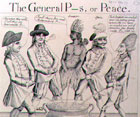 This manly gathering is a brutal criticism of what amounted to Lord
Shelburne's arrangement for the loss of America to Britain, through his
bungled handling of the peace proceedings at the end of the American Revolution.
National stereotypes are blatant and, as in so many other images, the Dutchman
is identified by his pipe.
This manly gathering is a brutal criticism of what amounted to Lord
Shelburne's arrangement for the loss of America to Britain, through his
bungled handling of the peace proceedings at the end of the American Revolution.
National stereotypes are blatant and, as in so many other images, the Dutchman
is identified by his pipe.
39
James Gillray (British, 1757–1815)
German Luxury, or Repos à l'Allemande
Hand-colored etching, published by Hannah Humphrey, January 12, 1800
Arents Tobacco Collection
Presumably relating to the arrival of the German Legion in England,
this print shows a soldier in rather dire straits. A portrait of Frederick
the Great hanging on the wall indicates his national identity, while the
torn Brussels Gazette alludes to his roving career. The incoming Germans
were described as "fine men, but ill-mounted, and in my opinion a bad description.
. . . It is the fashion, however, to admire them much." The crooked pipe
is an almost exclusively German phenomenon.
40
John Greenwood (British, b. Boston, 1727–1792)
Seated farmer with his pipe
Mezzotint, n.d.
Print Collection, Isaac John Greenwood Collection
41-44
Unidentified (British, 1st half 18th century)
Title page
Mynheer Bacon-Face, Captain of an East-India Man, and Don Diego de los
Nafos, a Spanish Factor
Mercurius Sublimate, a Chymist, and His Man Crucible
Mynheer van Funk, a Dutch Skipper, Peter Terrible Wingbeard, a Virginia Planter
and Hogan-Mogan Long-Pipe, a Dutch Indian Governor
Four etchings from the series: "Lilliputian Humorists Drawn as Big as the Life," 1730
Arents Tobacco Collection
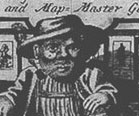
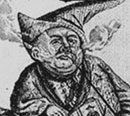
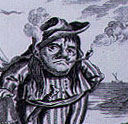
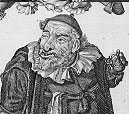
45
Thomas Rowlandson (British, 1756–1827)
after G. M. Woodward (British, 1760–1809)
Dutchman: Mynheer van Neverfelt Large Brecho Love Cabbecho Dutch Doggero,
a Great Merchant at Rotterdam
Etching in: George Alexander Stevens (British, 1710–1784). A Lecture
on Heads, with additions, as delivered by Mr. Charles Lee Lewes. To which is
added, An Essay on Satire. Embellished with Twenty-five Humorous Characteristic
Prints, From Drawings by G. M. Woodward, Esq. London: W. Wilson for Vernor,
Hood, and Sharpe, 1808
Print Collection, Duyckinck Collection
This lecture, performed first by Lewes in 1764, aims to teach proper
conduct by satirizing the inappropriate behavior of such vulgar individuals
as the "Dutchman" pictured. In a biting commentary on the greed of the
Dutch merchant class, Mynheer van Neverfelt, etc. is described as someone
who "looks upon money to be the greatest good . . . and a pic[k]led herring
the greatest dainty. If you would ask him what wisdom is, he'll answer
you, Stock. If you ask him what benevolence is, he'll reply, Stock; and
should you enquire who made him, he would say, Stock; for Stock is the
only Deity he bows down to."
46
Unidentified, after Jacques Grasset de Saint-Sauveur (French, 1757–1810)
Matelot Hollandais [Dutch sailor]
Hand-colored etching in: Jacques Grasset de Saint-Sauveur. Costumes Civils
actuels de tous les peuples connus, dessinés d'après nature,
gravés et coloriés, Accompagnés d'une Notice Historique
sur leurs Coutumes, Moeurs, Religions, &c. [Contemporary civilian costumes
of all known peoples, drawn from nature, engraved and colored. Accompanied
by an historical notice regarding their customs, habits, religions, etc.].
Paris: Pavard, 1788
Art and Architecture Department
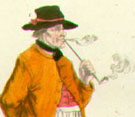 The image of a Dutch sailor is accompanied by a "historical notice
on Holland," in which political, religious, and social systems are discussed.
The French author's emphasis, at this critical date, was on Holland's democratic
nature. Among the examples given, it is said that the Dutch eat, drink,
even smoke together from the same plate, glass, and pipe.
The image of a Dutch sailor is accompanied by a "historical notice
on Holland," in which political, religious, and social systems are discussed.
The French author's emphasis, at this critical date, was on Holland's democratic
nature. Among the examples given, it is said that the Dutch eat, drink,
even smoke together from the same plate, glass, and pipe.
Costume series originated, in part, from an impulse of mapping and cataloguing
the known world. Understanding how a people looked and dressed, and where
and how they lived, provided information about the rest of the world, and
also, by contrast, about oneself.
47
Jakob Adam (Austrian, 1748–1811)
Griechischer Kaufmann [Greek Merchant]
Etching in his: Bildungen des gemeinen Volks zu Wien [Portraits of the
common people of Vienna]. Vienna, 178–
Print Collection, Cadwalader Fund
This etching of a rather placid Greek merchant shows, if nothing else, that
within virtually every society, there is at least one figure who can be associated
with tobacco smoking. The extra-long pipe and exotic robes define him as
foreign, in a city very much on the threshold of the East.
48
Giovanni Battista Finazzi (Italian, mid-18th century)
Young couple in a landscape
Engraving bound with a set of plates for Venetian fans, 1740
Print Collection, Kennedy Fund
The text below the smoker and his maid intimates that smoking and drinking
are not going to make any bright ideas jump into your head.
49
Johann Wilhelm Baur (1600–1642)
Moresci [Moors]
Etching, from a series of costume plates dedicated to Don Paolo Giordano II
Orsino, Duke of Bracciano, 1636
Print Collection, Kennedy Fund
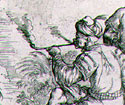 Baur was a prolific etcher who tended to produce prints in series,
and this ethnographic reportage depicting military costume from all over
the world is no exception. Pipe-smoking contributes to the masculine image
of the soldier in general, but even more to the leisurely, exotic image
associated with the moors. American Indians are the only other figures
depicted smoking in this series, suggesting that Baur still considered
it a foreign activity.
Baur was a prolific etcher who tended to produce prints in series,
and this ethnographic reportage depicting military costume from all over
the world is no exception. Pipe-smoking contributes to the masculine image
of the soldier in general, but even more to the leisurely, exotic image
associated with the moors. American Indians are the only other figures
depicted smoking in this series, suggesting that Baur still considered
it a foreign activity.
50
Joseph Marie Vien (French, 1716–1809)
Chef des Eunuques [Chief of the eunuchs]
Etching from Caravanne du Sultan à la Mecque [The Sultan's caravan in
Mecca], 1749
Print Collection, Kennedy Fund
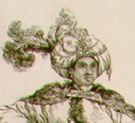 In this etching, one of a series of 32 prints representing the company
who traveled with the Sultan to Mecca, the pipe carried by the chief of
the eunuchs seems to have an almost solely decorative purpose. Along with
the sumptuous fabrics and languorous pose, however, it successfully conveys
a feeling of meditative solitude appropriate to a European understanding
of the Islamic East.
In this etching, one of a series of 32 prints representing the company
who traveled with the Sultan to Mecca, the pipe carried by the chief of
the eunuchs seems to have an almost solely decorative purpose. Along with
the sumptuous fabrics and languorous pose, however, it successfully conveys
a feeling of meditative solitude appropriate to a European understanding
of the Islamic East.
51
Unidentified (British, late 17th century)
L'Asie [Asia]
Mezzotint, n.d.
Arents Tobacco Collection
Tea from China, like coffee from Arabia and chocolate from Central and
South America, was introduced into England around 1650, radically transforming
European social habits and institutions.
52
Unidentified (British, 1st quarter 18th century?)
The Baccanalian Turk
Mezzotint, n.d.
Print Collection, Duyckinck Collection
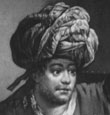 This inexpensive miniature mezzotint –a standard size in the
18th-century British print market –almost makes a mockery of Turkish
dress. The figure who toasts us appears to be an Englishman in turban and
robe, perhaps an actor dressed for a role. The mug (of beer) is decidedly
northern European, as are the clay pipe and pot of coals for lighting it.
This inexpensive miniature mezzotint –a standard size in the
18th-century British print market –almost makes a mockery of Turkish
dress. The figure who toasts us appears to be an Englishman in turban and
robe, perhaps an actor dressed for a role. The mug (of beer) is decidedly
northern European, as are the clay pipe and pot of coals for lighting it.
53
Nicolas de Larmessin (French, ca. 1640–1725)
Habit de Caffetier [Cafe owner's costume]
Etching from a series of fanciful depictions of trades and professions, ca.
1690
Print Collection, Kennedy Fund
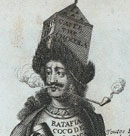 The plenitude of smoking and drinking products and paraphernalia worn
by this figure –a tea, coffee, and cocoa cannister for a hat, smoke
pouring out of his mouth and pipe, a steaming pot of chocolate (always
a drink at the time) in his left hand, a tray of "all sorts of waters and
liqueurs" in his right, pipes and spoons hanging from his sleeves and waist,
pipes for shoe ties and rolls of tobacco for stockings –renders him
a full catalogue of stimulating, intoxicating, and exotic new drinks.
The plenitude of smoking and drinking products and paraphernalia worn
by this figure –a tea, coffee, and cocoa cannister for a hat, smoke
pouring out of his mouth and pipe, a steaming pot of chocolate (always
a drink at the time) in his left hand, a tray of "all sorts of waters and
liqueurs" in his right, pipes and spoons hanging from his sleeves and waist,
pipes for shoe ties and rolls of tobacco for stockings –renders him
a full catalogue of stimulating, intoxicating, and exotic new drinks.
54
Unidentified (British, mid-17th century?)
Signiour Bobbadilli Puntado Cavalliro Puff or the Proud Vapouring Spaniard Engraving,
n.d.
Arents Tobacco Collection
As the first to encounter tobacco in the New World, the Spanish were
the first to be associated with it. In the course of the 16th and 17th
centuries, they were also at war with nearly every European country, not
to mention the heavy competition they engaged in over possession of goods,
trading, and land rights in the Americas. Needless to say, the harshness
of the message conveyed by this crassly humorous print is in large part
a result of those economic and political factors.
55
Jacob Gole (Dutch, ca. 1660–1737)
Man skating precariously, with pipe
Mezzotint, n.d.
Print Collection, Kennedy Fund









